Oligopoly Market Structure in the Australian Banking Industry
VerifiedAdded on 2020/05/28
|7
|1232
|449
AI Summary
The Australian banking industry is characterized by an oligopolistic market structure dominated by four major banks: National Australia Bank (NAB), Westpac, Commonwealth Bank (CBA), and Australia and New Zealand Banking Group (ANZ). These institutions account for approximately 85% of the housing loan market and hold a combined market share worth around 400 billion dollars. The high concentration suggests oligopolistic behavior, where few entities wield significant market power. This report explores the Australian government's interest in restructuring this sector to enhance transparency and competition among banks. An economic analysis reveals that this industry has substantial entry barriers due to regulatory requirements and existing market power dynamics. Using the Herfindahl-Hirschman Index (HHI), it is observed that the market has become highly concentrated over time, leading to economic inefficiencies such as deadweight loss. The report reflects on these findings by highlighting post-Global Financial Crisis challenges like capital inadequacy and global volatility. Recommendations for policymakers include diversifying risk exposure, preventing bank collusion, and enhancing competitive pressures within the sector. Ultimately, Australia’s banking system has shown resilience post-GFC but faces ongoing challenges that require strategic policy interventions to balance competition with stability.
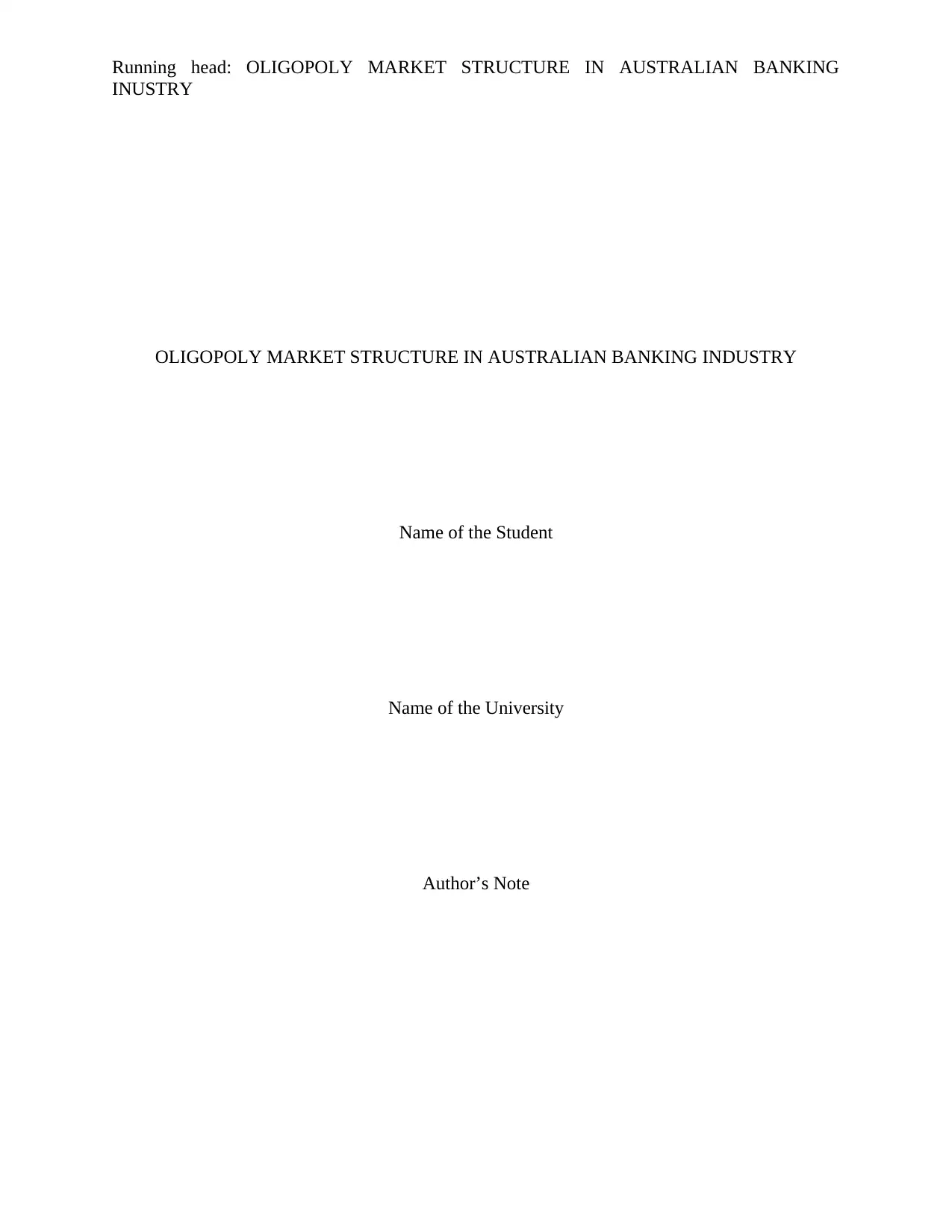
Running head: OLIGOPOLY MARKET STRUCTURE IN AUSTRALIAN BANKING
INUSTRY
OLIGOPOLY MARKET STRUCTURE IN AUSTRALIAN BANKING INDUSTRY
Name of the Student
Name of the University
Author’s Note
INUSTRY
OLIGOPOLY MARKET STRUCTURE IN AUSTRALIAN BANKING INDUSTRY
Name of the Student
Name of the University
Author’s Note
Paraphrase This Document
Need a fresh take? Get an instant paraphrase of this document with our AI Paraphraser
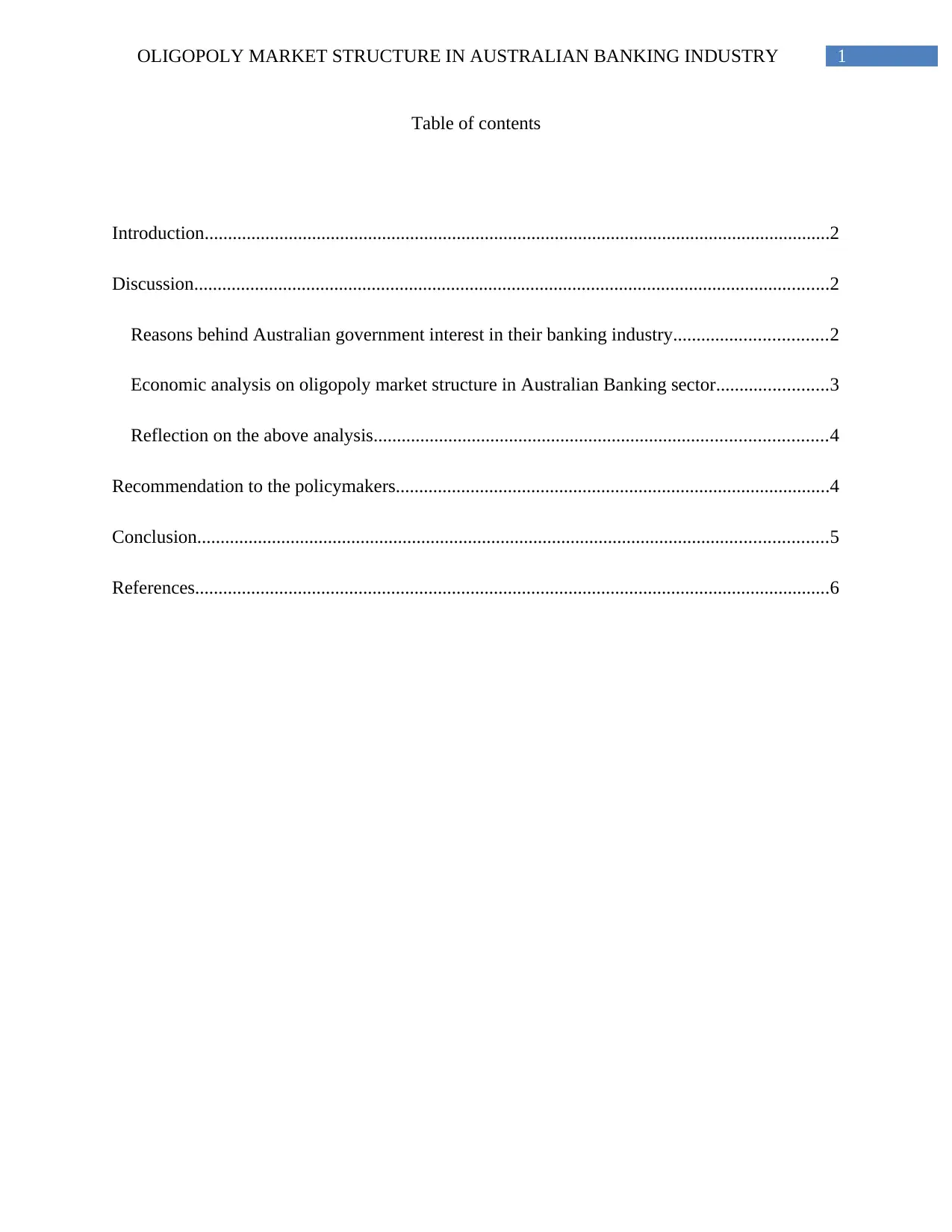
1OLIGOPOLY MARKET STRUCTURE IN AUSTRALIAN BANKING INDUSTRY
Table of contents
Introduction......................................................................................................................................2
Discussion........................................................................................................................................2
Reasons behind Australian government interest in their banking industry.................................2
Economic analysis on oligopoly market structure in Australian Banking sector........................3
Reflection on the above analysis.................................................................................................4
Recommendation to the policymakers.............................................................................................4
Conclusion.......................................................................................................................................5
References........................................................................................................................................6
Table of contents
Introduction......................................................................................................................................2
Discussion........................................................................................................................................2
Reasons behind Australian government interest in their banking industry.................................2
Economic analysis on oligopoly market structure in Australian Banking sector........................3
Reflection on the above analysis.................................................................................................4
Recommendation to the policymakers.............................................................................................4
Conclusion.......................................................................................................................................5
References........................................................................................................................................6
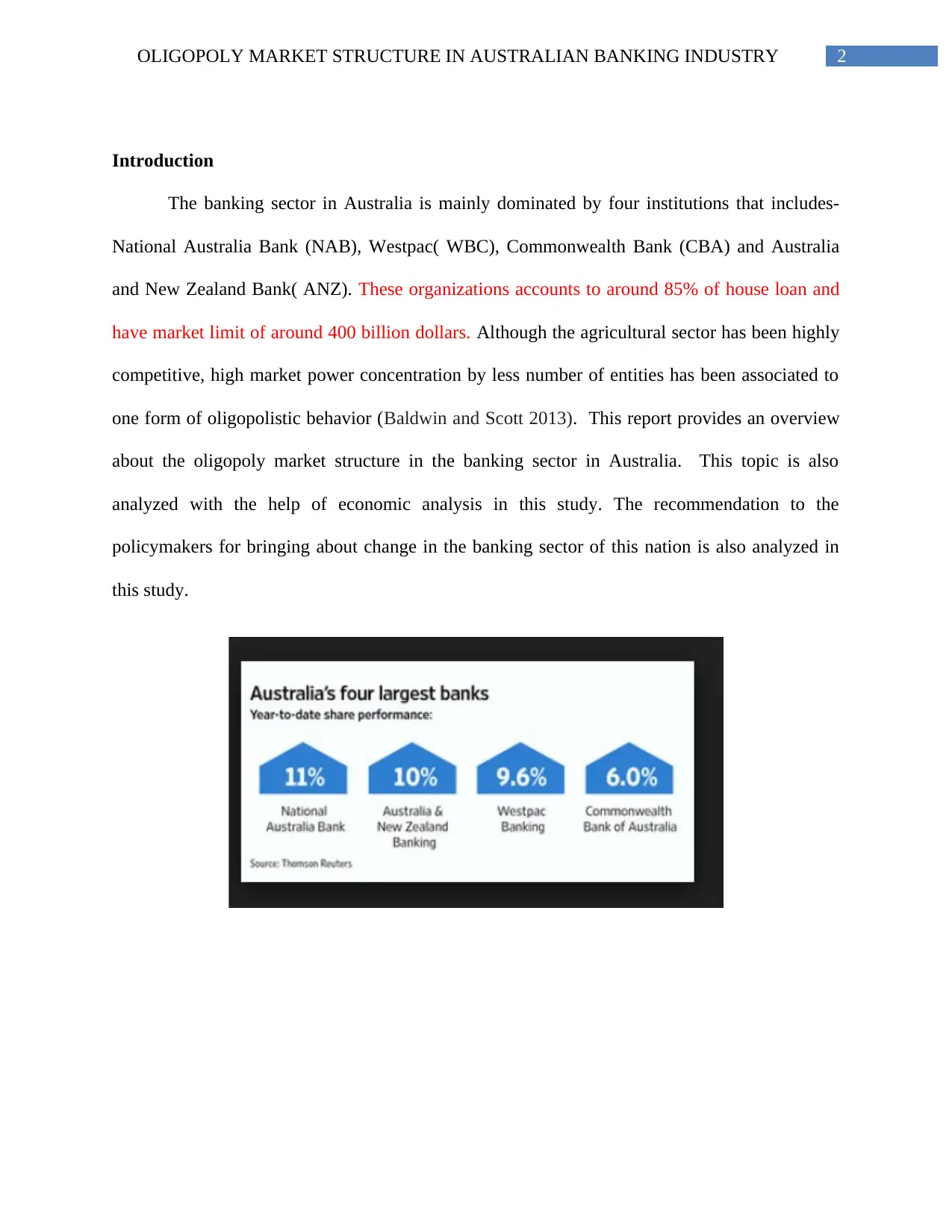
2OLIGOPOLY MARKET STRUCTURE IN AUSTRALIAN BANKING INDUSTRY
Introduction
The banking sector in Australia is mainly dominated by four institutions that includes-
National Australia Bank (NAB), Westpac( WBC), Commonwealth Bank (CBA) and Australia
and New Zealand Bank( ANZ). These organizations accounts to around 85% of house loan and
have market limit of around 400 billion dollars. Although the agricultural sector has been highly
competitive, high market power concentration by less number of entities has been associated to
one form of oligopolistic behavior (Baldwin and Scott 2013). This report provides an overview
about the oligopoly market structure in the banking sector in Australia. This topic is also
analyzed with the help of economic analysis in this study. The recommendation to the
policymakers for bringing about change in the banking sector of this nation is also analyzed in
this study.
Introduction
The banking sector in Australia is mainly dominated by four institutions that includes-
National Australia Bank (NAB), Westpac( WBC), Commonwealth Bank (CBA) and Australia
and New Zealand Bank( ANZ). These organizations accounts to around 85% of house loan and
have market limit of around 400 billion dollars. Although the agricultural sector has been highly
competitive, high market power concentration by less number of entities has been associated to
one form of oligopolistic behavior (Baldwin and Scott 2013). This report provides an overview
about the oligopoly market structure in the banking sector in Australia. This topic is also
analyzed with the help of economic analysis in this study. The recommendation to the
policymakers for bringing about change in the banking sector of this nation is also analyzed in
this study.
⊘ This is a preview!⊘
Do you want full access?
Subscribe today to unlock all pages.

Trusted by 1+ million students worldwide
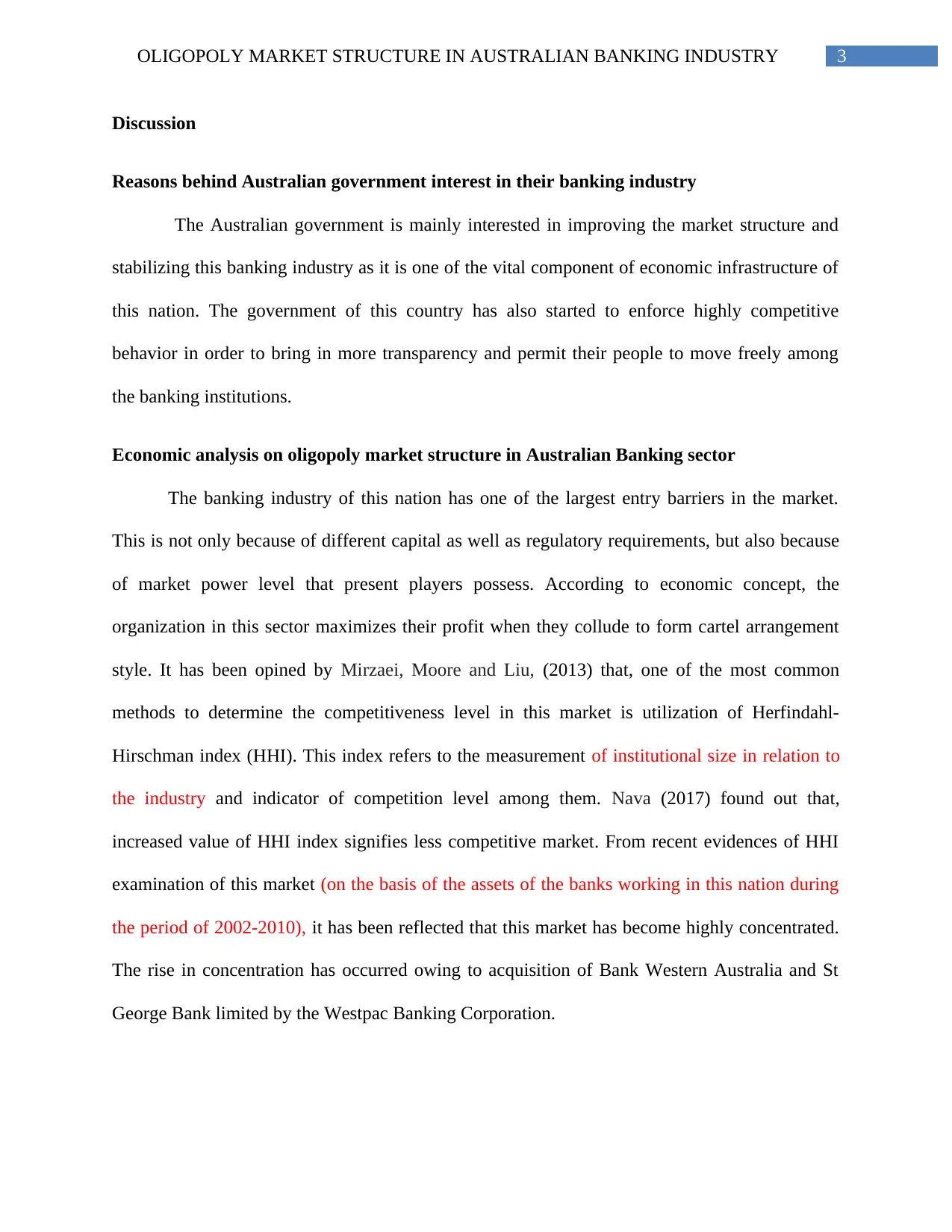
3OLIGOPOLY MARKET STRUCTURE IN AUSTRALIAN BANKING INDUSTRY
Discussion
Reasons behind Australian government interest in their banking industry
The Australian government is mainly interested in improving the market structure and
stabilizing this banking industry as it is one of the vital component of economic infrastructure of
this nation. The government of this country has also started to enforce highly competitive
behavior in order to bring in more transparency and permit their people to move freely among
the banking institutions.
Economic analysis on oligopoly market structure in Australian Banking sector
The banking industry of this nation has one of the largest entry barriers in the market.
This is not only because of different capital as well as regulatory requirements, but also because
of market power level that present players possess. According to economic concept, the
organization in this sector maximizes their profit when they collude to form cartel arrangement
style. It has been opined by Mirzaei, Moore and Liu, (2013) that, one of the most common
methods to determine the competitiveness level in this market is utilization of Herfindahl-
Hirschman index (HHI). This index refers to the measurement of institutional size in relation to
the industry and indicator of competition level among them. Nava (2017) found out that,
increased value of HHI index signifies less competitive market. From recent evidences of HHI
examination of this market (on the basis of the assets of the banks working in this nation during
the period of 2002-2010), it has been reflected that this market has become highly concentrated.
The rise in concentration has occurred owing to acquisition of Bank Western Australia and St
George Bank limited by the Westpac Banking Corporation.
Discussion
Reasons behind Australian government interest in their banking industry
The Australian government is mainly interested in improving the market structure and
stabilizing this banking industry as it is one of the vital component of economic infrastructure of
this nation. The government of this country has also started to enforce highly competitive
behavior in order to bring in more transparency and permit their people to move freely among
the banking institutions.
Economic analysis on oligopoly market structure in Australian Banking sector
The banking industry of this nation has one of the largest entry barriers in the market.
This is not only because of different capital as well as regulatory requirements, but also because
of market power level that present players possess. According to economic concept, the
organization in this sector maximizes their profit when they collude to form cartel arrangement
style. It has been opined by Mirzaei, Moore and Liu, (2013) that, one of the most common
methods to determine the competitiveness level in this market is utilization of Herfindahl-
Hirschman index (HHI). This index refers to the measurement of institutional size in relation to
the industry and indicator of competition level among them. Nava (2017) found out that,
increased value of HHI index signifies less competitive market. From recent evidences of HHI
examination of this market (on the basis of the assets of the banks working in this nation during
the period of 2002-2010), it has been reflected that this market has become highly concentrated.
The rise in concentration has occurred owing to acquisition of Bank Western Australia and St
George Bank limited by the Westpac Banking Corporation.
Paraphrase This Document
Need a fresh take? Get an instant paraphrase of this document with our AI Paraphraser
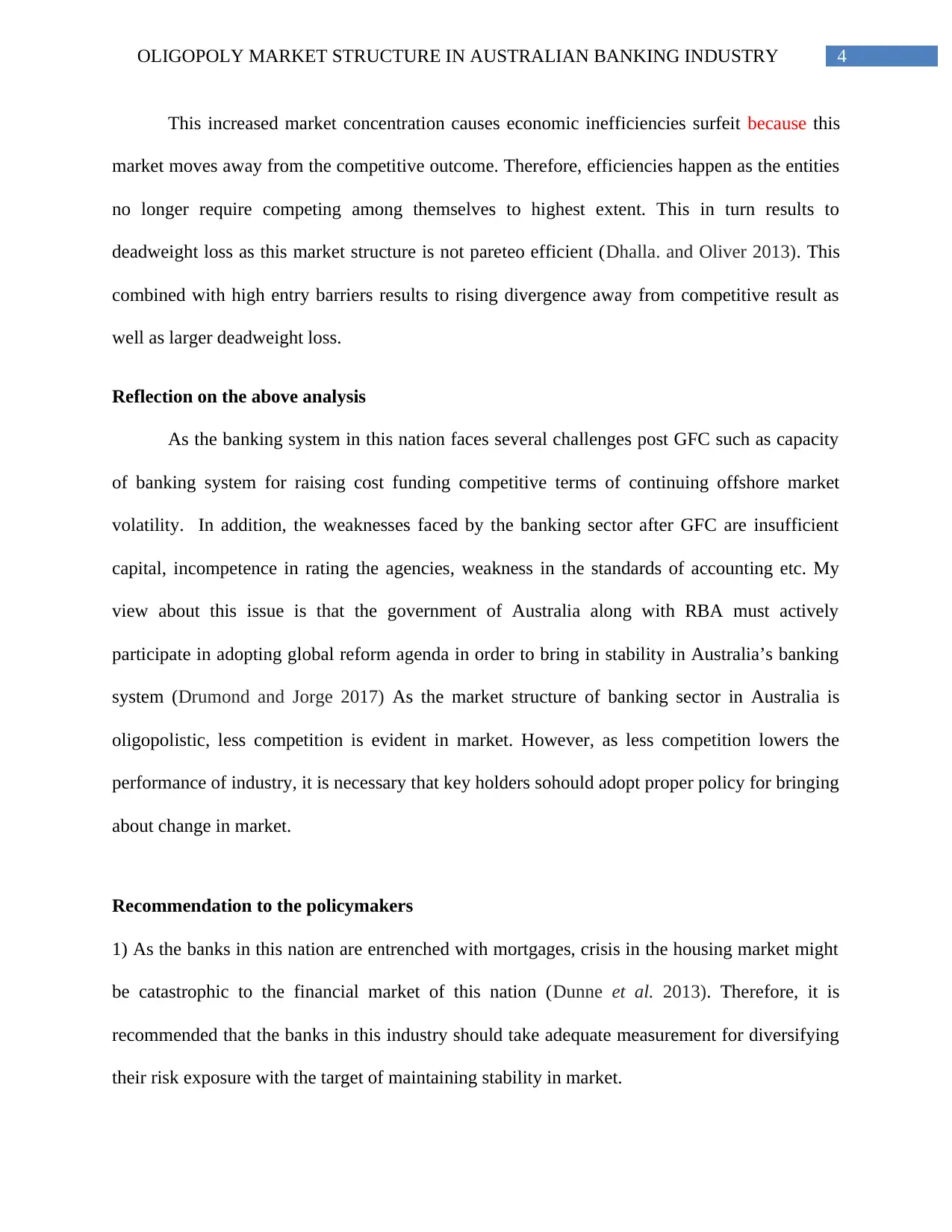
4OLIGOPOLY MARKET STRUCTURE IN AUSTRALIAN BANKING INDUSTRY
This increased market concentration causes economic inefficiencies surfeit because this
market moves away from the competitive outcome. Therefore, efficiencies happen as the entities
no longer require competing among themselves to highest extent. This in turn results to
deadweight loss as this market structure is not pareteo efficient (Dhalla. and Oliver 2013). This
combined with high entry barriers results to rising divergence away from competitive result as
well as larger deadweight loss.
Reflection on the above analysis
As the banking system in this nation faces several challenges post GFC such as capacity
of banking system for raising cost funding competitive terms of continuing offshore market
volatility. In addition, the weaknesses faced by the banking sector after GFC are insufficient
capital, incompetence in rating the agencies, weakness in the standards of accounting etc. My
view about this issue is that the government of Australia along with RBA must actively
participate in adopting global reform agenda in order to bring in stability in Australia’s banking
system (Drumond and Jorge 2017) As the market structure of banking sector in Australia is
oligopolistic, less competition is evident in market. However, as less competition lowers the
performance of industry, it is necessary that key holders sohould adopt proper policy for bringing
about change in market.
Recommendation to the policymakers
1) As the banks in this nation are entrenched with mortgages, crisis in the housing market might
be catastrophic to the financial market of this nation (Dunne et al. 2013). Therefore, it is
recommended that the banks in this industry should take adequate measurement for diversifying
their risk exposure with the target of maintaining stability in market.
This increased market concentration causes economic inefficiencies surfeit because this
market moves away from the competitive outcome. Therefore, efficiencies happen as the entities
no longer require competing among themselves to highest extent. This in turn results to
deadweight loss as this market structure is not pareteo efficient (Dhalla. and Oliver 2013). This
combined with high entry barriers results to rising divergence away from competitive result as
well as larger deadweight loss.
Reflection on the above analysis
As the banking system in this nation faces several challenges post GFC such as capacity
of banking system for raising cost funding competitive terms of continuing offshore market
volatility. In addition, the weaknesses faced by the banking sector after GFC are insufficient
capital, incompetence in rating the agencies, weakness in the standards of accounting etc. My
view about this issue is that the government of Australia along with RBA must actively
participate in adopting global reform agenda in order to bring in stability in Australia’s banking
system (Drumond and Jorge 2017) As the market structure of banking sector in Australia is
oligopolistic, less competition is evident in market. However, as less competition lowers the
performance of industry, it is necessary that key holders sohould adopt proper policy for bringing
about change in market.
Recommendation to the policymakers
1) As the banks in this nation are entrenched with mortgages, crisis in the housing market might
be catastrophic to the financial market of this nation (Dunne et al. 2013). Therefore, it is
recommended that the banks in this industry should take adequate measurement for diversifying
their risk exposure with the target of maintaining stability in market.
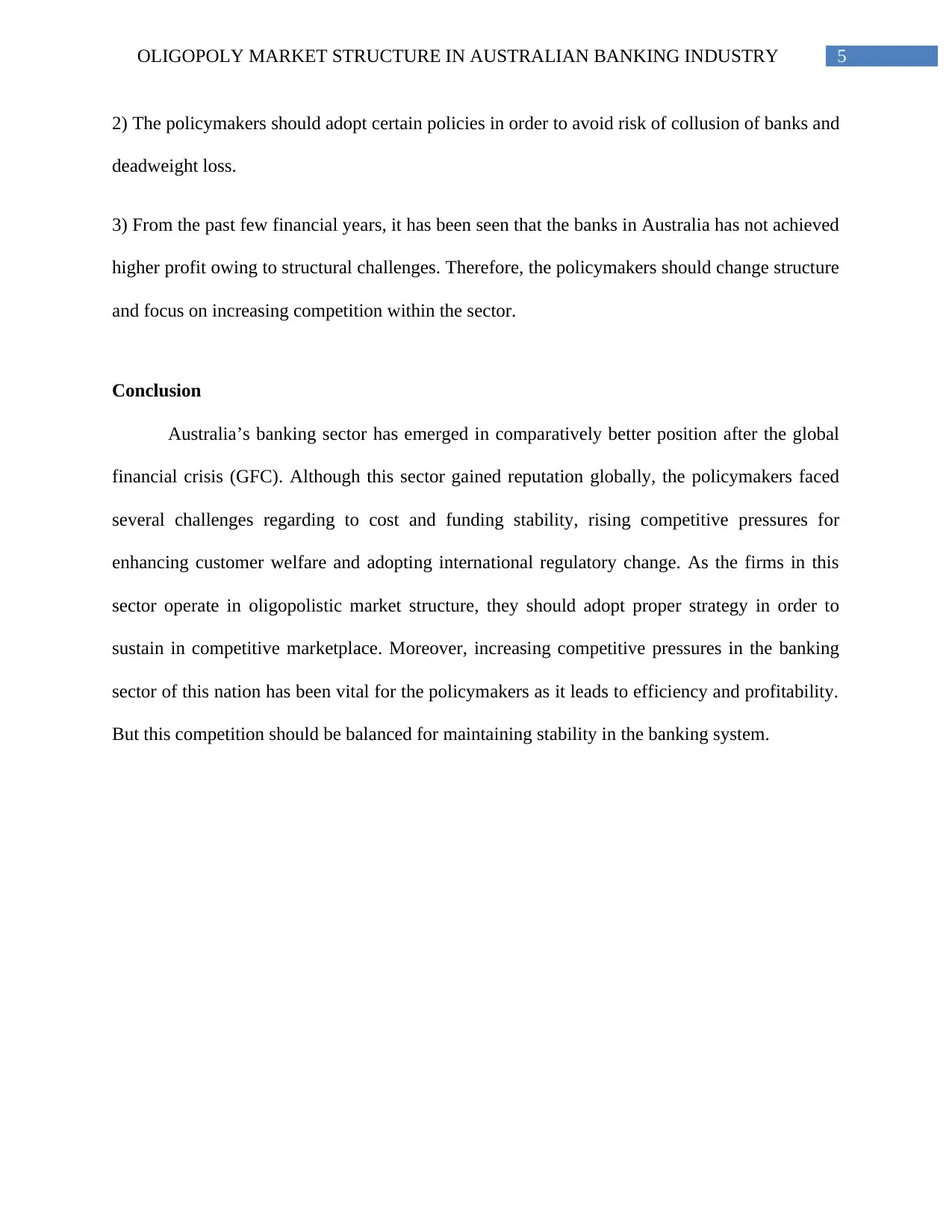
5OLIGOPOLY MARKET STRUCTURE IN AUSTRALIAN BANKING INDUSTRY
2) The policymakers should adopt certain policies in order to avoid risk of collusion of banks and
deadweight loss.
3) From the past few financial years, it has been seen that the banks in Australia has not achieved
higher profit owing to structural challenges. Therefore, the policymakers should change structure
and focus on increasing competition within the sector.
Conclusion
Australia’s banking sector has emerged in comparatively better position after the global
financial crisis (GFC). Although this sector gained reputation globally, the policymakers faced
several challenges regarding to cost and funding stability, rising competitive pressures for
enhancing customer welfare and adopting international regulatory change. As the firms in this
sector operate in oligopolistic market structure, they should adopt proper strategy in order to
sustain in competitive marketplace. Moreover, increasing competitive pressures in the banking
sector of this nation has been vital for the policymakers as it leads to efficiency and profitability.
But this competition should be balanced for maintaining stability in the banking system.
2) The policymakers should adopt certain policies in order to avoid risk of collusion of banks and
deadweight loss.
3) From the past few financial years, it has been seen that the banks in Australia has not achieved
higher profit owing to structural challenges. Therefore, the policymakers should change structure
and focus on increasing competition within the sector.
Conclusion
Australia’s banking sector has emerged in comparatively better position after the global
financial crisis (GFC). Although this sector gained reputation globally, the policymakers faced
several challenges regarding to cost and funding stability, rising competitive pressures for
enhancing customer welfare and adopting international regulatory change. As the firms in this
sector operate in oligopolistic market structure, they should adopt proper strategy in order to
sustain in competitive marketplace. Moreover, increasing competitive pressures in the banking
sector of this nation has been vital for the policymakers as it leads to efficiency and profitability.
But this competition should be balanced for maintaining stability in the banking system.
⊘ This is a preview!⊘
Do you want full access?
Subscribe today to unlock all pages.

Trusted by 1+ million students worldwide
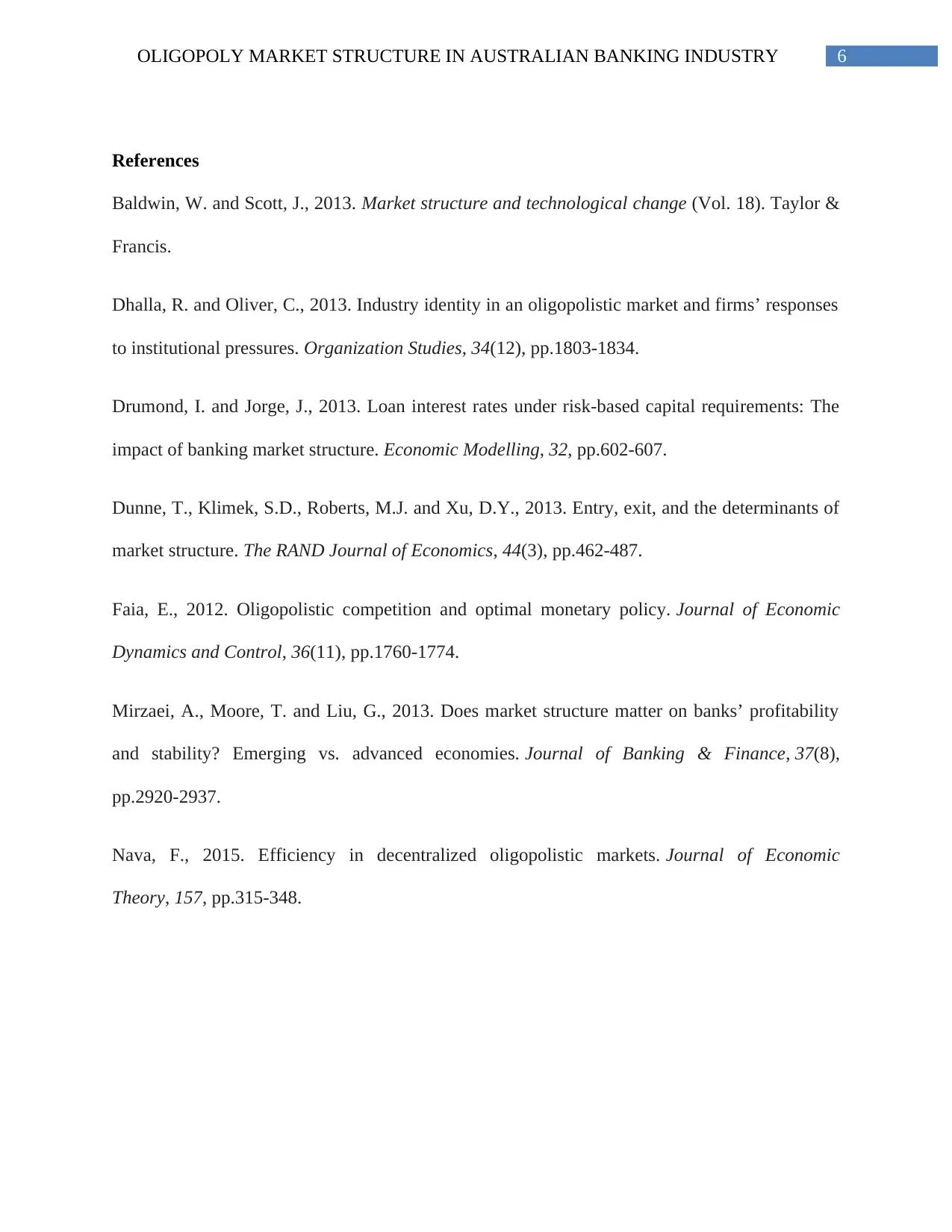
6OLIGOPOLY MARKET STRUCTURE IN AUSTRALIAN BANKING INDUSTRY
References
Baldwin, W. and Scott, J., 2013. Market structure and technological change (Vol. 18). Taylor &
Francis.
Dhalla, R. and Oliver, C., 2013. Industry identity in an oligopolistic market and firms’ responses
to institutional pressures. Organization Studies, 34(12), pp.1803-1834.
Drumond, I. and Jorge, J., 2013. Loan interest rates under risk-based capital requirements: The
impact of banking market structure. Economic Modelling, 32, pp.602-607.
Dunne, T., Klimek, S.D., Roberts, M.J. and Xu, D.Y., 2013. Entry, exit, and the determinants of
market structure. The RAND Journal of Economics, 44(3), pp.462-487.
Faia, E., 2012. Oligopolistic competition and optimal monetary policy. Journal of Economic
Dynamics and Control, 36(11), pp.1760-1774.
Mirzaei, A., Moore, T. and Liu, G., 2013. Does market structure matter on banks’ profitability
and stability? Emerging vs. advanced economies. Journal of Banking & Finance, 37(8),
pp.2920-2937.
Nava, F., 2015. Efficiency in decentralized oligopolistic markets. Journal of Economic
Theory, 157, pp.315-348.
References
Baldwin, W. and Scott, J., 2013. Market structure and technological change (Vol. 18). Taylor &
Francis.
Dhalla, R. and Oliver, C., 2013. Industry identity in an oligopolistic market and firms’ responses
to institutional pressures. Organization Studies, 34(12), pp.1803-1834.
Drumond, I. and Jorge, J., 2013. Loan interest rates under risk-based capital requirements: The
impact of banking market structure. Economic Modelling, 32, pp.602-607.
Dunne, T., Klimek, S.D., Roberts, M.J. and Xu, D.Y., 2013. Entry, exit, and the determinants of
market structure. The RAND Journal of Economics, 44(3), pp.462-487.
Faia, E., 2012. Oligopolistic competition and optimal monetary policy. Journal of Economic
Dynamics and Control, 36(11), pp.1760-1774.
Mirzaei, A., Moore, T. and Liu, G., 2013. Does market structure matter on banks’ profitability
and stability? Emerging vs. advanced economies. Journal of Banking & Finance, 37(8),
pp.2920-2937.
Nava, F., 2015. Efficiency in decentralized oligopolistic markets. Journal of Economic
Theory, 157, pp.315-348.
1 out of 7
Related Documents
Your All-in-One AI-Powered Toolkit for Academic Success.
+13062052269
info@desklib.com
Available 24*7 on WhatsApp / Email
![[object Object]](/_next/static/media/star-bottom.7253800d.svg)
Unlock your academic potential
Copyright © 2020–2025 A2Z Services. All Rights Reserved. Developed and managed by ZUCOL.





